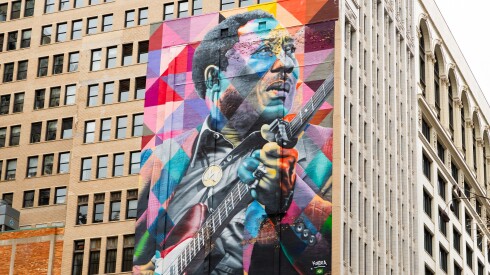Via dei Vecchietti, 4, 50123 Firenze FI, Italy
When people think of Florence, they usually think of Renaissance art and crowded museums filled with altarpieces and “Madonna and Child” images. While the Renaissance is the biggest draw of this historic city, there is a lot more to its art-museum scene. The Palazzo Strozzi is a fine example of a museum that doesn’t just showcase great art but also plays an important role in the community. Inside this Renaissance palace—a work of art in itself—visitors will find temporary exhibitions that cover a variety of time periods and cultures.
On Thursday evenings, the courtyard is transformed into a social hub with hip Florentines having drinks and coffee at the café and on outdoor couches. The museum also offers free entrance to the downstairs exhibition space on select evenings and, in summer, hosts movie and music nights. Palazzo Strozzi has also gotten on board with making art an interactive experience, especially for children. Parents can purchase a family ticket which includes kid-friendly activities including workshops, sketching in the galleries, storytelling, and “stroller tours.”
On Thursday evenings, the courtyard is transformed into a social hub with hip Florentines having drinks and coffee at the café and on outdoor couches. The museum also offers free entrance to the downstairs exhibition space on select evenings and, in summer, hosts movie and music nights. Palazzo Strozzi has also gotten on board with making art an interactive experience, especially for children. Parents can purchase a family ticket which includes kid-friendly activities including workshops, sketching in the galleries, storytelling, and “stroller tours.”
Piazza Pitti, 1, 50125 Firenze FI, Italy
You will likely see Bronzino’s famous portrait of Eleonora (or Eleanor) de Toledo, in the Uffizi, during your visit to Florence. The Spanish noblewoman who became the duchess of Florence in 1539 when she married Cosimo I de’ Medici was unusual for her time, playing an active role in politics and as a patron of the arts. Her patronage extended to garden design, in its infancy (at least in Europe) in the 16th century. Eleonora commissioned the Boboli Gardens behind the Pitti Palace as a green escape from the city; they continue to provide a retreat for travelers today.
Among the earliest examples of the formal compositions that would dominate garden design through the 20th century, the grounds are dotted with classical statues and fountains while straight axes run up and down the hillside with an apparent disregard for topography. A moment in design history can be experienced first hand here. There’s a feeling that the man who planned the gardens (Niccolò Tribolo) conceived a formal plan and then simply laid it atop the site. Principles of garden design were later to shape city planning. The allées of the Boboli Gardens were early models for grand boulevards leading the eye to distant monuments. One of the pleasures of gardens, however, is that you don’t need to know their histories to enjoy the flowers in bloom or the sounds of birdsong and splashing fountains.
Among the earliest examples of the formal compositions that would dominate garden design through the 20th century, the grounds are dotted with classical statues and fountains while straight axes run up and down the hillside with an apparent disregard for topography. A moment in design history can be experienced first hand here. There’s a feeling that the man who planned the gardens (Niccolò Tribolo) conceived a formal plan and then simply laid it atop the site. Principles of garden design were later to shape city planning. The allées of the Boboli Gardens were early models for grand boulevards leading the eye to distant monuments. One of the pleasures of gardens, however, is that you don’t need to know their histories to enjoy the flowers in bloom or the sounds of birdsong and splashing fountains.
Costa S. Giorgio, 2, 50125 Firenze FI, Italy
The Bardini Garden is one of Florence‘s best kept secrets. It was built in the 12th century as part of a large estate owned by the Mozzi family. During the 20th century it was closed for many years and only reopened in 2005 after significant restoration. The garden is small and easy to walk through in about an hour and its hillsides offer spectacular views of Florence. Wandering among the terraces and flowers is an excellent way to escape from the touristy historic center and instead feel part of what this old city once was. During the off-season and in the morning or late afternoon, you may be the only visitor! The Bardini Garden can be accessed in two ways. One is by going into Boboli Gardens and exiting on the left side—this can be hard to find, but is marked on the Boboli Gardens map you receive on admission. The second way is via street da Costa San Giorgio 2. The garden opening hours vary according to season. It is closed the first and last Monday of each month. Admission is included in the Boboli Gardens ticket, or can be purchased separately for around 10 euros (and includes admission to the villa). There is also a restaurant with beautiful terrace views.
Piazza di Santa Croce, 50122 Firenze FI, Italy
Standing in the Piazza Santa Croce, a statue of Dante looms over the square from the corner. Florence, where Durante degli Alighieri’s journey through hell, purgatory, and paradise was to begin but not end. In 1829 a tomb was built for him in the Basilica of Santa Croce—the largest Franciscan church in the world. The tomb has remained empty ever since as Dante’s body lies in Ravenna.
Via Borgo Ognissanti, 42, 50123 Firenze FI, Italy
Domenico Ghirlandaio’s beautiful fresco representing the Last Supper is one of my favorite paintings in Florence, and luckily, most tourists ignore it, so you may find you have the place to yourself.














